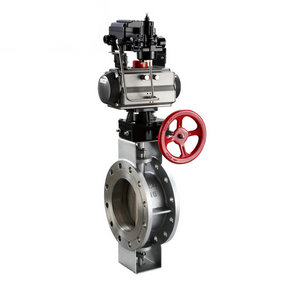How to adjust if the double clip pneumatic butterfly valve cannot be closed properly? There are many types of pneumatic butterfly valves, which can be summarized into three categories: long pillow type, pneumatic butterfly valve rubber bag type, and membrane type. Its basic structure is similar to the structural profile of tire phase capsule film, including outer rubber layer, cord layer, inner rubber layer, and steel ring
After vulcanization, products often need some post-treatment to become qualified products. This includes:
① Edge removal and trimming of mold products to make the surface of products smooth and clean, and the shape and size meet the requirements;
② Through some special processes, such as surface treatment of products, the use function of products for various purposes has been improved;
③ Products containing fabric framework, such as tape and tire, shall be cooled by hot stretching and cooled under inflation pressure after vulcanization, so as to ensure that the size and shape of the products are not disordered and have good use function.
1、 Trimming of mold products after vulcanization
When mold products are vulcanized, the rubber will flow out along the parting surface and other parts of the mold, forming an overflow rubber edge, also known as burr or flash. The number and thickness of the rubber edge depend on the structure and precision of the mold, the parallelism of the plate of the plate vulcanizer, and the amount of residual rubber. The rubber edge of the products produced by the current borderless mold is not thin. Sometimes it is taken off when the mold is lifted or can be removed with a slight wipe. However, this kind of mold is expensive and easy to be damaged. Most molded products need to be repaired after vulcanization.
1. Manual finishing
Manual trimming is an ancient trimming method, which includes manually punching the rubber edge with a punch; Use scissors, scrapers and other tools to remove the glue edge. The quality and speed of manually manipulated finished products will also vary from person to person. It is required that the geometric dimensions of finished products must meet the requirements of product drawings without scraping Scratch and deformation. Before trimming, the trimming parts and technical requirements must be clear, and accurate trimming methods and tools must be grasped.
2. Mechanical finishing
Mechanical trimming refers to the process of trimming die products with various special machines and corresponding process methods. It is a way to improve the seniors at present.
(1) Mechanical punching trimming removes the glue edge of products with the help of pressure machine, punching die and punching knife. The products suitable for this method and the model products whose rubber edges can be placed on the bottom plate of the punching die or punching knife, such as bottle stoppers, leather cups, etc. For products with high glue content and low hardness, the impact cutting method is generally used to cut the edges, which can reduce the uneven edges and side dents caused by the large elasticity of the products after cutting; For products with lower glue content and higher hardness, the knife edge die can be directly used for punching. In addition, punching can also be divided into cold cutting and hot cutting. Cold cutting refers to punching under room temperature, which requires high punching pressure of equipment and good punching quality; Hot cutting refers to cutting at a high temperature - f. During punching, it is necessary to prevent high temperature from contacting products for too long, which will affect product quality.
(2) Mechanical cutting trimming is applicable to trimming of products with large shape and size, and cutting tools are used. All cutting machines on one side are special machines, and different products use different cutters. For example, if there are rubber strips with different lengths at the surface air hole and exhaust line after tire vulcanization, the rubber strips must be cut off with grooved tools under the premise of tire rotation.
(3) Mechanical grinding trimming For die products with inner holes and outer circles, grinding squares are usually used. The cutting tool to be ground is a grinding wheel with certain particle size. The precision of grinding trimming is low, and the grinding surface is coarse and coarse, which may contain residual sand particles, affecting the use effect.
(4) Low temperature shot blasting trimming can be used for fine products with high trimming quality requirements, such as 0-shaped rings, small cups, etc. Use liquid nitrogen or dry ice to rapidly cool the product to below the brittleness temperature, and then spray metal or plastic bullets at high speed to break the flash off and finish trimming.
(5) Low temperature brush grinding trimming is to remove the adhesive edge of frozen products with two nylon brushes rotating around the horizontal axis.
(6) Low temperature drum trimming is an early method of freezing trimming. It uses the impact force generated by drum rolling and the friction force between products to break and fall off the flash of products that have been frozen below the embrittlement temperature. The drum is generally octagonal in shape to increase the impact force of products in the drum. The drum speed should be moderate, and adding abrasives can improve efficiency. For example, the trimming process of electrolytic capacitor plug is to use low-temperature drum trimming.
(7) Low temperature vibration trimming is also called vibration freezing trimming. The products are subject to spiral vibration in the circular sealing box, and there is a strong impact between products and between products and abrasives, causing the frozen brittle rubber edge to fall. Low temperature vibration trimming is better than low temperature drum trimming, with low product damage rate and high production efficiency.
(8) Low temperature swing and shake trimming is applicable to small or micro products or micro products containing metal framework, and together with abrasives, the adhesive edges in product holes, corners and grooves are removed.


